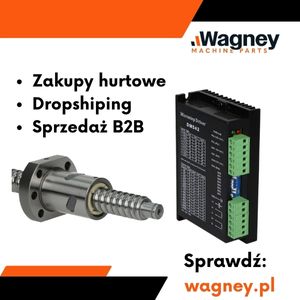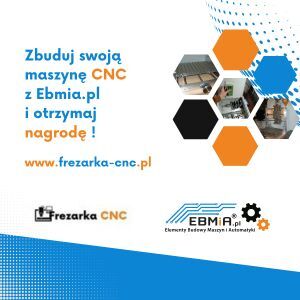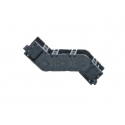Dosyć szczegółowy opis procesu.
Fragment pogrubiony zawiera proporcje.
1- Degrease/clean parts.
Hot water (potable)
Large buckets (one for cleaning, one for rinsing)
Degreasing solution (can be commercial degreaser, laboratory degreaser, or chemical such as TSP)
Large 3M pads for scrubbing
Toothbrushes for cleaning small parts and crevasses
Rubber or latex gloves
Cleaning your rifle parts is crutial for a good finish. Any finish be it wood or metal is all about surface preparation. This first cleaning step should remove all cosmoline and other oils in the rifle. It's best to boil whatever parts you can in a degreaser to make sure all the hidden areas are oil free. Cleanliness is next to Godliness, for your firearms too. Do not skimp. Soak overnight and boil, scrub everything and make sure your rifle is clean. Rinse the rifle well to make sure there is no residue.
2- Sandblast.
Blasting cabinet
Air compressor and nozzle
Blast media (70 or 80 grit aluminum oxide)
4" grinder
Conical wire wheel attachment
Eye protection
Rubber or latex gloves
This is one of the most time consuming part of this process. Take care to blast all parts of your rifle but be careful on areas such as the breech end of the barrel as you don't want to affect headspace. For the blasting we used 70 grit aluminum oxide. 80 grit was what was recommended, but we had good results with 70 grit. Something that made this process go a lot faster was taking a wire wheel brush on a 4" grinder and brushing off the top layers of the finish before blasting. This prevented contamination of the blast media, but also posed a danger as the wire wheels will fling off the wires. These are dangerous and eye protection is a must. Full face shield is recommended but not necessary. After blasting, do not touch the rifle with bare hands as oils will contaminate the process. It is fine to set rifles to the side for a while, away from any water or humidity to avoid flash rusting, while other processes are taking place.
3- Mixing Parkerizing Solution.
This step should occur during the blasting, if labor allows. Read the instructions carefully and verify this step when the product arrives.
The kit will contain:
Phosphoric Acid 85% Solution
Powdered Calcinated Zinc Oxide
Powdered Atomized Steel
Extra Materials:
Lab goggles
Rubber lab apron
Rubber gloves
1000mL Beaker
Scale (gram resolution)
Thermometer
Large Stainless Steel or Chrome spoon for stirring
Stainless steel Parkerizing Tank
Range top stove or other heating element
Stainless steel wire basket/strainer
Parkerizing does not adhere to stainless steel or chrome. Thus your tank should be made from either of these materials. The tank needs to be big enough to hold a barreled receiver for whatever firearm you are doing, but should not be so big as to not be deep enough to cover the rifle with. Avoid having the rifle lay on its side or touch the edges. This poses some tricky constraints. A little research and trips to the junk yard can yield some suitable stainless steel tanks to be used for a parkerizing tank.
To mix the solution, mix in 30mL phosphoric acid to every 1000mL water. Bring solution to 180*F - 190*F. The solution must not go below 170*F. Add 14g calcinated zinc oxide and 5g atomized steel per 1000mL water. Maintain boiling solution for 30 minutes before any immersion. Add smaller scaled amounts of solution to replace evaporated or solution lost to steam.
A few notes about safety: Phosphoric acid will burn contact lenses. Wear fully enclosed goggles if you wear contacts. Proper ventilation is needed. Phosphoric acid fumes can make you sick. Don't stand over the tank and breathe real deep. Be smart, print out the MSDS on all chemicals used so you know what to do if an accident occurs.
4- Cleaning parts again.
After the rifles are blasted and the park tank is sitting for its necessary 30 minutes, it's time to clean rifles again. This goes the same as step 1. Here special care will be needed to make sure there's no blast media or oils hiding in the parts. These can ruin the parkerizing solution. They will need good scrubbings with toothbrushes in crevasses. Rinsing in near boiling water helps remove unwanted contaminates. Flash rust can be a problem here so move fast to the next stages after scrubbing the rifle well and rinsing it off.
5- Denatured Alcohol Dip.
Plastic tub
Denatured alcohol
This step is necessary. Do not skip.
After the rifles are thuroughly washed, place the rifle in a bath of denatured alcohol. If only doing one or two rifles, one can probably just rinse them off generously, though this might waste good DA. This preps the metals bonds for accepting the oxide layer the parkerizing tank will deposit. It also helps again to remove oils and contaminates. Be sure to keep any DA away from heating elements or flame.
6- Hot Water Pre-Bath.
After removing the rifle from the alcohol tub, immerse them into hot water bath for 5-7 minutes. This step is crucial. Heating the parts to temperature prevents putting cold parts into the parkerizing solution which will lower the solutions temperature.
7- Parkerizing
When rifles are sufficiently heated, transfer them to parkerizing tank. With solution at 180*F, start with a 10 minute dip. Small parts need to be stirred in the strainer. This is a piece by piece step as all metals will react differently with the acid bath. What you are looking for is for the parts to stop bubbling. When they have the process has stopped. No part should sit in the tank for longer than 20 minutes. When we did this, the first parts were still slightly bubbling at 20 minutes at 180*F. Later on, the temperature crept up a bit to 190*F. At that time, no rifle sat in the tank for longer than 10 mintues before it stopped bubbling.
The bubbling is the reaction of the phosphoric acid with the metal and the zinc or manganese oxides depositing on the metal. This is what you want.
8- Post-Treatment Rinse
When parts are removed they must be immediately rinsed, again preferably with boiling water as to promote rapid drying. A toothbrush will be handy for scrubbing off any flock (zinc or manganese residue) or film that might coat the part from the tank. Large parts should be hung to dry while small parts can be placed on paper towels.
9- Post Treatment
Make sure your parts are dry and preferably still hot! Parkerizing loves to absorb. That is why for post parkerizing treatment I recommend duracoating immediately after parkerizing. This is, in my opinion, the best finish on a rifle you can ask for. Use the zinc oxide solution if you duracoat as it will come out a very light grey and any color will look good on top of it. Since duracoat is a sprayed on application, having parts completely dry will ensure you get no runs as you spray on the duracoat.
If you are not duracoating, immediately put your parkerized parts into any oil of your choice. I recommend WD40 as it is a water displacer and will immediately absorb into the finish. You might want to experiment with different types of motor oils and gun oils however. The parkerized, oil soaked parts can be heat cured in an oven at low temperatures to yield different color results. The coveted patina green of WWII is achieved through this method.
Remember, safety is your responsibility. This is actually easier than it seems, but it does take proper planning and proper materials. If you have questions, I can answer some, but what I can't answer, I'll point you in the right direction to finding it. Enjoy and happy parkerizing!!
Znaleziono 3 wyniki
Wróć do „parkeryzacja - warunki”
- 16 maja 2010, 19:01
- Forum: Obróbka metali
- Temat: parkeryzacja - warunki
- Odpowiedzi: 9
- Odsłony: 5577
- 14 maja 2010, 21:41
- Forum: Obróbka metali
- Temat: parkeryzacja - warunki
- Odpowiedzi: 9
- Odsłony: 5577
Z linka, którego wrzuciłem - http://230grain.com/showthread.php?t=25131 - wynika, że temperatura pomiędzy 82.2C-93.3°C. Wikipedia pisze, że 88–99 °C.numerek pisze:temp pracy coś koło 180 st C
I jeszcze jeden: http://www.projectguns.com/parkerizing.html
- 14 maja 2010, 18:24
- Forum: Obróbka metali
- Temat: parkeryzacja - warunki
- Odpowiedzi: 9
- Odsłony: 5577











